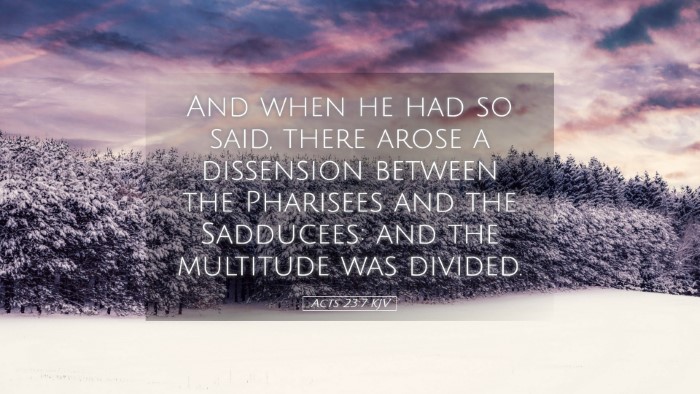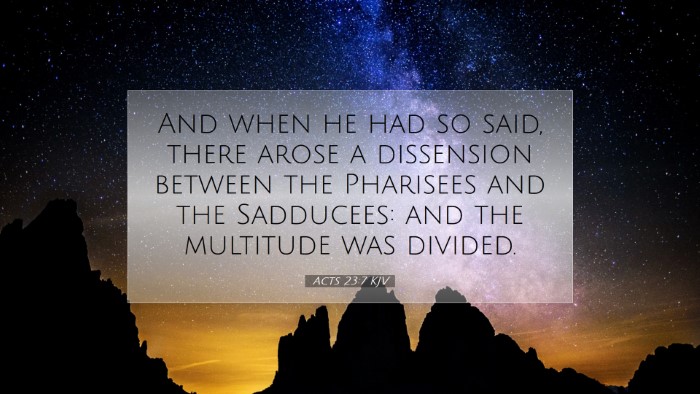Commentary on Acts 23:7
Verse: "And when he had so said, there arose a dissension between the Pharisees and the Sadducees: and the assembly was divided."
Introduction
Acts 23:7 serves as a pivotal moment in Paul’s defense before the Sanhedrin, revealing both the internal conflicts within the Jewish leadership and the broader theological divides that characterized the first-century Jewish milieu. The discourse among the Pharisees and Sadducees not only highlights the controversial nature of the resurrection but also foreshadows the challenges that Paul would face as he continued his mission of spreading the Gospel.
Contextual Understanding
The context of Acts 23 is critical to understanding verse 7. Paul stands trial before the Sanhedrin following his arrest. His manner of addressing the council—claiming to be a Pharisee and asserting that he is on trial due to the hope of resurrection—incites a fierce dispute among the leaders.
The Pharisees and Sadducees
The Pharisees were known for their strict adherence to the Law and belief in the resurrection, while the Sadducees denied the resurrection and were typically more aligned with the priestly class. This fundamental disagreement sets the stage for the division Paul exploits.
Theological Insights
-
Matthew Henry:
Henry emphasizes that Paul’s clever tactic in invoking the division of beliefs between the two groups demonstrates his keen understanding of the situation. By framing his defense around the doctrine of resurrection, he not only defends himself but also sheds light on the contested nature of resurrection theology within Judaism.
-
Albert Barnes:
Barnes points out the significance of the dissension that erupts as a manifestation of the deeper theological rifts within Jewish thought. He notes that such divisions can often arise even among those considered to be in leadership, underscoring the complexity of faith and belief in a community setting.
-
Adam Clarke:
Clarke suggests that this incident exemplifies the challenges faced by early Christians. He elaborates on how the division not only serves as a vehicle for Paul’s escape from a grave situation but also illustrates the reality that conflict can yield new opportunities for the spread of the Gospel.
Pastoral Reflections
For pastors, this passage presents profound reflections on the nature of conflict within the church and community. It encourages leaders to recognize that theological disagreements can be a source of division but can also serve as opportunity for growth and clarity in teaching. The example set by Paul shows that wisdom and insight are crucial when navigating complex situations.
Application for Students and Theologians
Students and theologians may draw from this incident rich theological and ecclesiological implications. The diverse array of beliefs within the early church highlighted in this incident calls attention to the importance of grappling with doctrinal differences in modern contexts. It encourages critical engagement with doctrinal issues such as resurrection, authority of scripture, and the role of tradition versus innovation in the faith community.
Conclusion
Acts 23:7 is a microcosm of the larger challenges faced in the early church, illustrating both the strength and frailty of belief systems. The divisions among the Pharisees and Sadducees serve as a reminder that within the body of believers, conflict is often unavoidable but can lead to deeper understanding and stronger faith.


